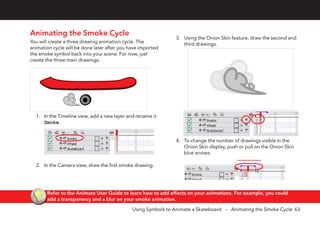

It is a really effective type of animation and surprisingly easy to produce. The idea being the desire to have the words or drawing to magically appear to be drawn out as you watch the movie.

You can then reparent and set up the bones and their corresponding artwork in a new formation.Ĭopy Resting Position to All Key Frames: Maintains all the position information in the keyframes that are part of an animated sequence, while restoring the puppet's bones to the set-up position and resetting all the transformation information back to zero.Recently on the Toon Boom Studio Forums a question was asked about doing tele-strator style animation. Orient to Path: Forces the element connected to the path to follow the motion path-see PegsĬopy Resting Position to Current Frame: Brings the skeleton and artwork back to the set-up position only on the currently selected frame. When it is enabled, the interpolation calculates the X and Y axis values and keeps the Z-axis value as constant-see Pegs

When you create a motion path on the Z-axis, the automatic interpolation calculates the X, Y and Z axis values. You can also use the Rotate tool from the Animation Tools toolbar.Īpply Pivot to: Select to which transformation you want to apply the pivot to.Ĭonstant Z: This option is disabled by default. Rotation: Type in the desired rotation angle value. You can also use the Skew tool from the Animation Tools toolbar. Skewing: Type in the desired skewing angle value. Keep Proportions : Enable this option to keep proportions when scaling the skeleton. You can also use the Scale tool in the Animation Tools toolbar. Scale: Type in the desired width and height scaling values: 1 = 100%. Vector Quality : Choosing the vector quality level of your skeleton will either improve or depreciate the result of the bone distortion effect.

You can disable this option to hide the influence areas. Show Influence: By default this option is enabled, letting you see the influence areas of the skeleton's bones in the Camera view. Before the master element of the Skeleton Effect is animated, the center point is situated in the centre of the Camera view. Show Root: Displays the root, which is the centre point of the bone structure. Show Track: Displays the motion path of your animation in the Camera view-see Pegs. You can also change the default colour for each new Skeleton Effect you will add to your project using the Preferences panel-see Refer to Preferences. The colour will change in both the Timeline and Camera view. Pick a colour to instantly change the colour of the selected Skeleton Effect elements. Skeleton Colour: Click in the colour square to open the Select Colour dialog box.
#How to make a loop in toon boom studio 8 how to
To learn how to adjust the velocity-see Adjusting the Velocity and Functions and Adjusting the Velocity Loop Mode: Displays if the layer is looped-see Change Loops to learn more about looping a peg movement.Įdit Velocity: Click on this button to display the Skeleton Element in the Function Editor view. Start: Displays the first frame number to which a keyframe is inserted on the Skeleton Effect element.ĭuration: Displays the duration of the animation of the Skeleton Effect element. Name: Displays the name of the selected Skeleton Effect element. You can animate this element using the animation tools available in the Animation Tools toolbar-see Using the Different Animation Tools. To learn more about animating trajectories and motion paths, see Setting the Scene.


 0 kommentar(er)
0 kommentar(er)
